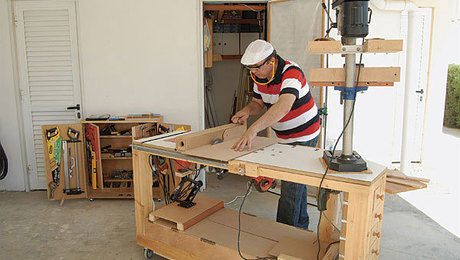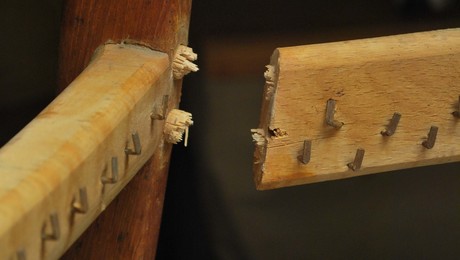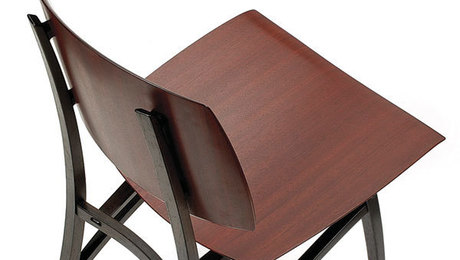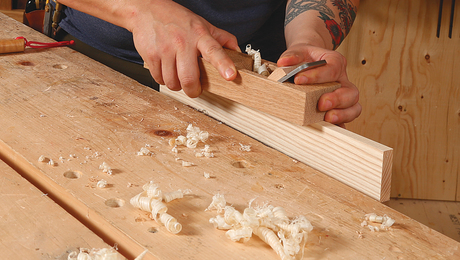STL255: Vic’s plywood workbench
Vic Tesolin joins Anissa and Ben to discuss economy shop life, his new workbench, making handplanes, and sharpening toothed planes.This episode is sponsored by Garrett Wade
Question 1:
From JD:
As a new woodworker I really enjoyed the sub-$1000 episode and I wanted to present a different challenge that always gets laughed off as a topic: apartment woodworking.
Woodworking is becoming a popular hobby in the tech industry and unfortunately a lot of us are stuck in cities with expensive real estate. If I had to guess, this is probably part of the reason for the rising popularity of hand tools. Unsurprisingly, there aren’t many woodworking content creators in this situation so nobody is really around to offer us advice on working (semi) quietly in small spaces.
I started around six months ago and pieced together what I could accomplish on my balcony, pic attached. I’d love to hear some more ideas or at least conversation on the topic.
 |
Question 2:
From Damon:
I have a medium toothed blade for my Veritas low angle jack plane. I can’t find much info on sharpening this kind of blade, but the instructions from Veritas say: “Sharpen and hone only the bevel; do not hone the face of the toothed blade, or you will damage the sharp points that actually do the cutting”.
Does this mean that I don’t even remove the burr from honing the bevel? How do you guys approach this kind of blade?
Segments:
Anissa – All time favorite tool: a cordless circular saw
Ben – All time favorite technique: Drilling out a dowel joint with a smaller bit, à la David Johnson.
 |
Vic: All-time favorite tool: A cordless power plane
note: I could not find the video of Toshio that AK mentioned
 |
Question 3:
From Alex:
I have a question for Vic Tesolin or really anyone who uses wooden hand planes.
In issue #288 Vic has an article on making a hand plane where the blade is secured in the body with a wedge that sits in grooves in the side of the plane body. On Vic’s blog post “how to put down a plane” you can find a plane that has the blade secured with a wedge pressing against a cross pin like you would see in a Krenov style plane. Is there an advantage/disadvantage between one and the other? Is there a minimum diameter for the cross pin that will put good pressure on the blade without denting the wedge itself?
Great show everyone. It almost goes without saying bu shop talk live is the reason I got my FWW unlimited membership.
 |
Every two weeks, a team of Fine Woodworking staffers answers questions from readers on Shop Talk Live, Fine Woodworking‘s biweekly podcast. Send your woodworking questions to [email protected] for consideration in the regular broadcast! Our continued existence relies upon listener support. So if you enjoy the show, be sure to leave us a five-star rating and maybe even a nice comment on our iTunes page.






















Comments
Good episode, you three.
I was interested to hear your takes on workbenches, and especially Vic's comments about his Baltic Birch explorations. I have been beating a certain drum about this subject for some years. I think it bears repeating...
The goal of a workbench top is that it be heavy, flat and smooth. Those qualities can be easily and inexpensively obtained by using a solid core door slab. You really can't do better for the price and the simplicity. I have mine topped with a sheet of 1/2 inch Baltic Birch, screwed through the door slab from below. My plan was to replace the birch ply when it became worn, but that hasn't happened yet in 15 years so I think it has proved itself well during hard usage.
To accommodate bench dogs, I ran a piece of 2x4 inch hard maple along the front edge with rectangular dog holes dadoed into it. The maple is screwed into the edge of the door slab, proud of it by 1/2 an inch, so when the Baltic birch was laid in place everything planed out evenly. Again, as simple, quick and inexpensive as it is possible to do.
Zolton
Fettling is knocking the scale off a weld. That's one meaning.
fettle: : state or condition of health, fitness, wholeness, spirit, or form —often used in the phrase in fine fettle
Log in or create an account to post a comment.
Sign up Log in